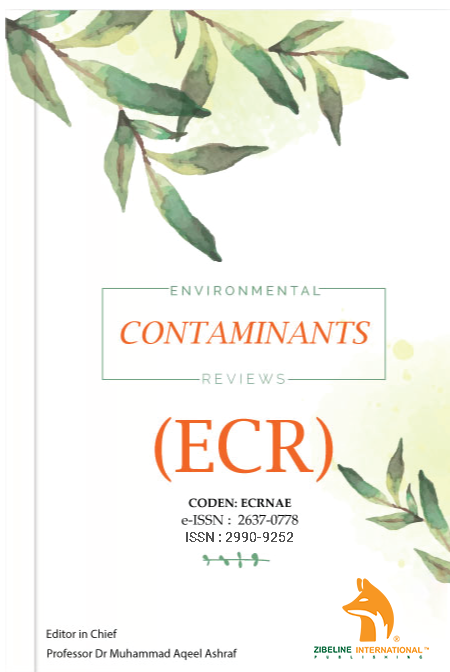
ASSESSMENT OF POLYCYCLIC AROMATIC HYDROCARBONS AND TOTAL PETROLEUM HYDROCARBONS IN SOILS OF OIL EXPLORATION HOST COMMUNITIES, UTILISING INDIGENOUS EARTHWORMS AS BIOINDICATORS IN THE COASTAL WETLANDS OF DELTA STATE
Journal: Environmental Contaminants Reviews (ECR)
Author: Biose E., Ogwo, P. A., Ogbonna P. C.b, Enuneku A.A., Agbate A. E., Omoigberale, M. O.
This is an open access article distributed under the Creative Commons Attribution License CC BY 4.0, which permits unrestricted use, distribution, and reproduction in any medium, provided the original work is properly cited
Doi:10.26480/ecr.01.2025.24.35
ABSTRACT
This study evaluated polycyclic aromatic hydrocarbons and total petroleum hydrocarbons in soils of oil exploitation host communities, utilising indigenous earthworms as bioindicators in the coastal wetlands of Delta State. Soil and earthworm samples at a depth of 0-20 cm were obtained from the same quadrant in five coastal wetlands in Delta State. Polycyclic aromatic hydrocarbons (PAHs) and total petroleum hydrocarbons(TPHs) were examined by Gas Chromatography with Flame Ionisation Detection (GC-FID).Sixteen (16) polycyclic aromatic hydrocarbons (PAHs) were identified in the soils such as Naphthalene, Acenaphthylene, Acenaphthene, Fluorene, Phenanthrene, Anthracene, Fluoranthene, Pyrene, Chrysene, Benzo(a)anthracene, Benzo(b)fluoranthene, Benzo(k)fluoranthene, Benzo(a)pyrene, Indeno (1,2,3-cd)pyrene, Dibenz (a,h)anthracene, and Benzo(g,h,i) perylene. The total PAH concentrations in soils were contaminated in the following order: Emevor (10049.543) > Effurun (3761.246) > Kwale (3260.261) >Olomoro (2020.273) > Sapele (control) (926.537). Earthworm samples collected from Kwale, Emevor, Effurun, and Olomoro demonstrated the bioaccumulation of fourteen (14) PAHs (Naphthalene, Acenaphthylene, Fluorene, Phenanthrene, Anthracene, Fluoranthene, Pyrene, Chrysene, Benzo(a)anthracene, Benzo(k)fluoranthene, Benzo(a)pyrene, Indeno (1,2,3-cd)pyrene, Dibenz(a,h)anthracene, and Benzo(g,h,i) perylene) with BAF values exceeding 1. Twenty-seven (27) out oftwenty-eight (28) Total petroleum hydrocarbon (TPH) compounds were identified in soils, including nnonane, n-decane, n-undecane, n-dodecane, n-tridecane, n-tetradecane, n-pentadecane, n-hexadecane, nheptadecane,Pristane, n-octadecane, Phytane, n-nonadecane, n-eicosane, n-heneicosane, n-docosane, ntricosane,n-tetracosane, n-pentacosane, n-hexacosane, n-heptacosane, n-octacosane, n-nonacosane, ntricontane,n-hentriacontane, n-dotriacontane, and n-tritriacontane, while n-octane was absent. The total TPH findings of soils were contaminated at different amounts in the following sequence; Emevor (6788.221μg/kg) surpasses Kwale (6440.235 μg/kg), which exceeds Effurun (6111.785 μg/kg), followed by Olomoro(4013.103 μg/kg), with Sapele (control) at (1218.361 μg/kg). Earthworm samples collected from the study location exhibited bioaccumulation of sixteen (16) TPH compounds (n-octane, n-nonane, n-decane, nundecane,n-dodecane, n-pentadecane, n-heptadecane, n-eicosane, n-hexacosane, n-heptacosane, noctacosane,n-nonacosane, n-tricontane, n-hentriacontane, n-dotriacontane, and n-tritriacontane) with BAF values exceeding 1. This study’s results reveal that earthworms serve as effective indicators of the specified contaminant. This study reinforces the necessity for the remediation of oil spills in Delta State, as the survival of human life and other living organisms in this region is jeopardised.
KEYWORDS
Coastal wetlands, Polycyclic aromatic hydrocarbon, total petroleum hydrocarbon, Earthworms (Aporrectodea longa)), Bioaccumulation factor (BAF)

